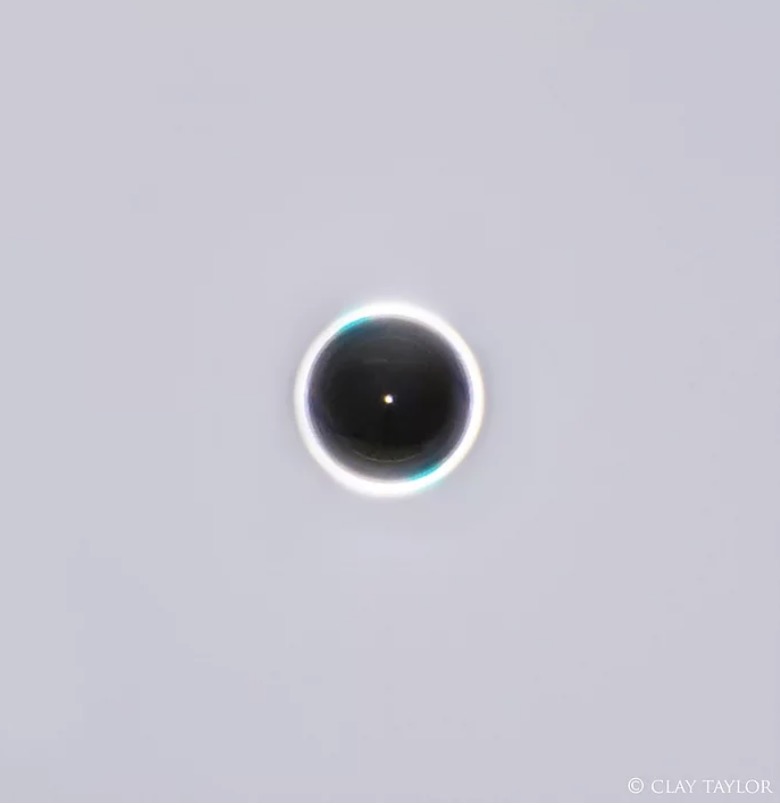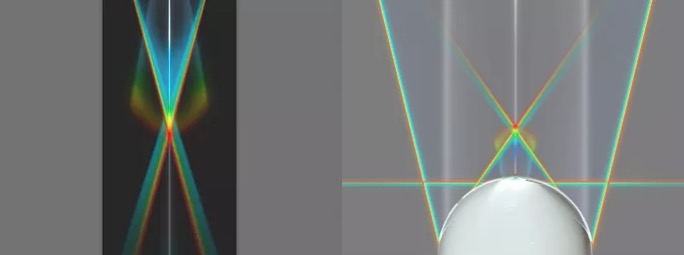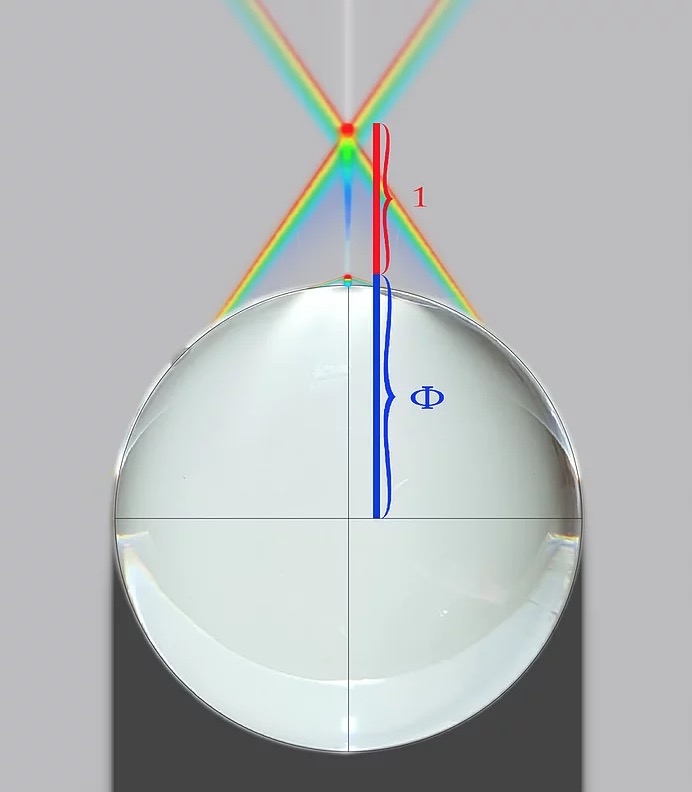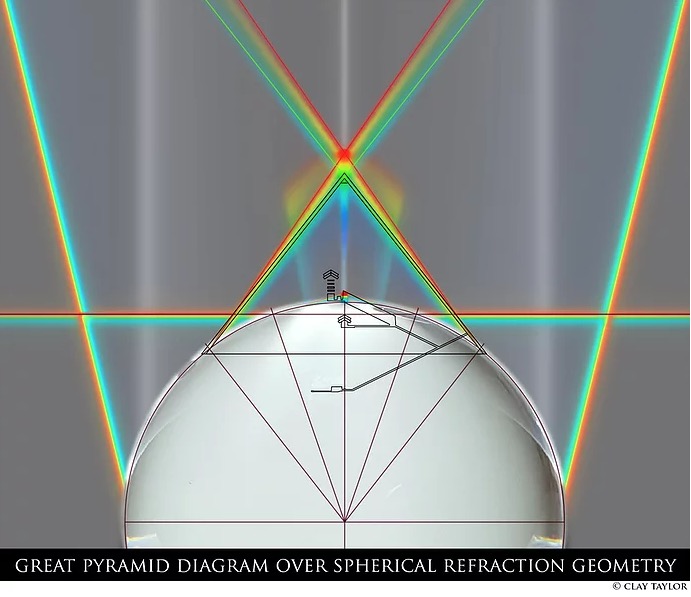A principle question that arises in the study of geometry and the study of light concerns the behavior of light upon the sphere.
The sphere itself is nothing less than the universal and perfect shape. It is in a way the first and last possibility of the great miracle of dimension- the one great marriage of singularity and infinity, the unification of polarity and the prime cause of the 3 base dimensions of triangulated space. It is at once a single point, a single surface and yet a container of infinite points. It is infinitely divisible, has complete curvature that expresses every angle and both convexity and concavity is built into it. Clearly, to describe its characteristics is to employ words that seem paradoxical and contradictory…
It is by means of the sphere that man and his science may come to truly understand nature and perhaps the high truth of cause. The entirety of true mathematics, geometry and physics owe their allegiance to its reason. Likewise, it has been praised throughout time as the shape of the heavens and god itself.
What would the sphere help reveal regarding the nature of light? I have worked to closely observe and document the many subtle dynamics of this question in many ways.
The image seen reflected upon a soap bubble for instance was quite a dizzying puzzle. The outer surface of the bubble is reflecting an image and so is the inner surface. You are also seeing light from beyond the bubble that made it through to your eye without reflection. Then there is the distortion of both that light and the reflected light from both hemispheres though the complete gradient of curvature. Then there is the refraction of the light into the color phenomena that we see in the soap bubble and more. The result is a highly complicated image with numerous subtleties easily overlooked.
Did you get all that? It is not easy to put some of these concepts into language, and yet we have all been playing with this shape since we were children. But let’s move on with confidence, it gets more and more interesting I promise!
The bubble has much to teach. Spherical reflection, spherical refraction, spherical polarity, the codependent duality of convexity and concavity… all directly perceivable in a simple soap bubble. This image above is my attempt to reproduce all these optical phenomena as accurately as possible.
While we are on the subject of bubbles, check out this video: https://youtu.be/GKvT1lRWhE0
Of course a crystal ball (or sphere made of optical glass) is by no means a more simple feat to understand. Visual electromagnetic information is converging upon it from all directions, resulting in some confounding, yet mesmerizing behaviors of light.
One of the principle phenomena of spherical optics is the flipping of the image of the world seen beyond it. However, this phenomena is entirely dependent upon the proximity of objects in relation to the sphere, as well as the receiver receiving the image (like your eye of the camera.) The image would at a certain ratio of distance magnify to an extent that it would eventually flip around to the proper orientation- a polar reversal.
Here is an example of the polar reversal of an image flipping from upside down to right side up. The image of an eye at distances far away enough from the sphere is upside down, as the landscape is in the prior image. The closer the camera or the eye image gets to the sphere, the more magnified the eye becomes, until the image totally flips right side up. The blue ring surrounding the eye is actually the upside down eye itself being magnified, prior to the boundary of polar reversal. This is an example of a fundamental behavior of space- that of a boundary condition. The material world is formed by means of boundary conditions. Every atom is made individual and distinct by a boundary condition, while simultaneously sharing a connection with the universe it is a constituent part of. Here immaterial light demonstrates this mysterious and fundamental feat by means of the universal shape of the sphere.
This proximity effect I was observing challenged some fundamental thoughts I had regarding light early on. One would naturally think that the light which falls upon a sphere, simply falls upon a sphere no differently regardless of how near or how far it was in relation to the sphere. I mean, you don’t see the image of the landscape flipping right side up within a portion of the image do you? What is different about the light that hit the sphere from several feet away compared to light that struck the sphere from 2 inches away? Perhaps light is more than photon particles or waves traveling through empty disconnected space? Maybe there is indeed an “etheric” magnetic field which defines space in a way which behaves in accordance to immutable harmonic laws we have not yet mastered?
It was evident there is indeed a definitive geometry that dictates this process, I just had to find methods to reveal what was occurring with the light rays. I decided to study the sphere as I would a prism. I would use the light of the sun only as it eliminates the proximity of the light source from being a factor in the perspective geometry. For instance, a flashlight, due to its proximity would magnify the shadows at an angle and cast a perspective and would give me less ideal measurements of the lensing and refraction effects generated by the sphere. The sun however is virtually at what we call an infinite distance. In geometry, at an infinite distance, 3 dimensional objects appear 2 dimensional. The shadows cast by an object from light rays from the sun are perfectly parallel. Thus the sun will provide an ideal and constant measure in the resulting phenomena.
The first method I tried was to create water vapor around the sphere and photograph the behavior of the sun rays. This method revealed in spectacular fashion one of the key behaviors of spherical lensing- the focal point.
Here we see all the sunlight that struck the adjacent hemisphere, focusing to a point. We see this light seemingly curve in mid air like a funnel, with an amazingly bright central ray which suddenly stops at a constant and conclusive point in space. Like a magnifying glass of the ideal shape, this beam is extremely focused and powerful and has burned several things I own in the process of getting its picture taken. It seems almost unnatural even, like a light saber straight out of Star Wars. Why does the light beam terminate mid air at such a definitive point? How is it curving in mid air outside of the sphere?
Using the example of the image of the sphere with the eye, it is within the proximity of this light cone that the sun (if it were an observer itself) would essentially see the eye image as being right side up. Outside of this light cone, the eye would be observed by the sun as being upside down. The boundary of this light cone is where the eye has magnified to the circle which surrounds the corrected image within it. This boundary condition is a neutral characteristic- a condition of polar reversal/ polar interchange and is a critical concept to understand when seeking to comprehend magnetic fields and atomic theory. As we can see documented in the image of this light funnel, neutral boundary conditions (which have been given many names throughout time, such as dielectric field and many others) may take on several geometries. It may be a point, a circumference, a plane, a cone, an axis, an equator, and as revealed in magnetic fields, a spiral of stillness balancing the opposing magnetic polarity currents within the universal magnetic field they are a constituent of. This neutral element is one of the 3 base components of spacetime and all its manifestations of energy.
Here is where I should link to to the work of Jon DePew, whose discoveries my work is largely based on. Note that much of his work is based upon magnetic spherical geometry. His images are not just art, they are very important geometric concepts regarding magnetism and energy dimensions. A true pioneer:
I was able to make a precise measurement of this feature of the light. As expected, I found the focal point to extend out to a distance equal to half of the radius of the sphere. In music theory, this would represent the octave. One could say the sphere’s focal point essentially maintains the fundamental tone of the sunlight geometrically.
The light funnel emerges from a circle equal to 20 degrees in diameter to the 360 degrees of the circumference of the sphere, which would divide the circumference exactly 18 times.
I mentioned above the concept of the point of view of the sun in describing what was occurring here. Well, I was also able to capture what the sun would see from its “point of view.” I had to photograph the sphere from very far away with a camera small enough to obscure the sunlight as little as possible to do so.
I call this one, “Gods Eye View” 😉 The outer circumference and the point directly in the middle are absolutely illuminated with the suns own reflected light. This is the suns view perhaps of what Jon DePew calls “the neutral particle of matter.” It reminds me of the ancient Egyptian symbol for the Sun, or Amun Ra. We will see this phenomena revealed in more detail further below.
I knew there was much more to find. As I was studying color theory and light refraction at the time, I was intent on mapping the refraction effects the sphere produced.
Be sure to check out my main article concerning the nature of light, refraction and the “magnetic spectrum,” it is essential to understanding some of the principles described ahead: The Magnetic Spectrum of Inertial Polarization
My method to further reveal these effects was to somehow split the sphere at its central plane parallel to the suns rays. To do this, I produced a large, straight and thin paper and cut a hole into it exactly the size of the sphere. The sphere fit into it like a glove. By angling the paper edge directly towards the sun as to reduce its shadow as much as possible, I was able to reveal all the light phenomena that occurred over its planar surface area without restricting the suns access to the sphere itself.
Here are some of the images I produced in this process:
This revealed a much more elaborate hidden world of light than I expected with a multitude of specific light behaviors. It truly left me in awe for the better part of a week… and I would not pretend that awe has yet to leave me!
Again, the sun provided me with constant behaviors and definitive measurements. These features were present anytime the sun’s electromagnetic rays of light were being induced within this glass sphere. And make no mistake about it, that is exactly what we are studying here- the geometries of electroMAGNETIC induction and refraction.
I took detailed measurements of all the angles and positions and magnitude of these many optical features and reproduced them as exactly as possible in this single image. It is important to understand that all these angles and proportions would be preserved no matter the size of the sphere- the ratios of the light phenomena are all scaled along with the sphere’s dimensions.
What we see in this image as angled lines are in reality rainbow-like cones (as a matter of fact, they are the source of the rainbow phenomena.) The single straight lines are rays. There is one horizontal line which is a really fascinating rainbow that extends as a perfect flat disk from the front of the sphere. You can see the perfectly parallel cylinders that are the shadow of the sphere as well as the reflected light returning towards the sun from the circumference of the sun side hemisphere. A central ray reflects as well- this is the illuminated circle and point of light we saw in the “Gods Eye View image.”
Here are both hemispheres in greater detail, click to expand:
Clearly there are many dynamics available to be dissected in detail. I started by setting my sets on the key features of the refraction, with hopes they would reveal a guiding principle.
Directly parallel to the sun rays are extended two spectacular spectrum beams, one reflecting directly back towards the sun from the tip of the sun facing hemisphere and another beam extended from the exact opposite end. Once again, these beams had definite distances, terminating at a point as if dissolving into thin air. I expected I would find the golden ratio of Phi dictating these behaviors.
I took their measures and analyzed them just as I did the color wavelengths in my refraction project I linked to earlier (I found phi ratios determining the central wavelengths of all the colors that resulted in the process of refraction.) As it is the size of the sphere itself which manages the scales of these beams, I measured the relationship of the 3 of them together. The large ray pointing away from the sun minus the diameter of the sphere to the diameter of the sphere minus the smaller ray pointing back towards the sun gave me the ratio Phi !
This is how I have most often been finding phi when studying light and electromagnetism. How do you get a ratio of two values between 3 objects? You would find it in the difference between the 3. Furthermore, if something has a magnitude of sorts, like a diameter in the case of this sphere, or a wavelength or frequency in the case of light and color, the difference between magnitudes may provide a ratio, since we are not otherwise dealing with dimensionless points.
This light phenomena discovery further proved to me Jon DePew’s premise regarding energy (also very much eluded to by others such as Ed Leedskalnin and Walter Russell and countless ancient philosophies and teachings passed down through time in countless manner.) All energy is composed of 2 opposing magnetic currents and the neutral particles of matter, and that the ultimate inherent value between these 3 things is Phi (which should not be limited to the single numerical ratio we prescribe to it, but rather as dividing something equally.) See some of the work Jon shares at www.coralcastlecode.com
It is as if the sun and sphere agreed perfectly. What better analogy to a “neutral particle of matter” than a clear and transparent sphere- with the light energy that touches it being perfectly divided into two opposing magnetic spectrum beams in golden proportion to the neutral particle sphere itself?
Of course, I found phi manifested in the geometry of the light phenomena in many other ways as well. For example, the center of the sphere to the top of the miniature spectrum beam protruding just above its surface in relation to the top of the spectrum beam extending beyond that one:
This brings me to an amazing feature of spherical refraction that I would like to conclude upon for now.
As you may notice, these spectrum beams are fortified by a refraction cone as well as a central column of white light. A rainbow cone of light emerges from the surface of the sphere and converges to a point, from where it is essentially inverted beyond as it then expands beyond this point. Yes… another hard one to convey in words.
If you held a piece of paper perpendicular to the light cone, you would see it projecting a circular rainbow which would decrease in size the closer you came to the central color of green light, from where the circle would then expand with the positions of the colors within the rainbow reversed. At a point, every color has its own center in this process which is manifested radially in the beam of colored light.
Here is a video I took of this exact phenomena (I uploaded this video to my channel too because it’s that good) -opens in new tab
A remarkable fact is that the angle that the rainbow light cone takes on the side which reflects back towards the sun is a very ancient and celebrated one, very much tied to countless mathematical constants. The angle it takes to the very center of this spectrum beam at the position of green light (the middle position of the visible light spectrum) is equal to 51.84 degrees from the perpendicular central plane of the sphere.
Drum roll please… this is the angle of the slope of the Great Pyramid of Giza!
Also, if I were to include the interior design of the pyramid, the surface of the sphere would be equal in height to the floor of the “King’s Chamber.” That smaller spectrum beam would start at that same level and extend to the top of the ceiling of the “Grand Gallery.” The queens chamber would touch upon the horizontal rainbow refraction disk and more.
*A few weeks after first publishing this article, I was contacted by a reader who was aware of work by Philip Laven who also works with spherical refraction and color theory and who had calculated the colors that refraction angles would produce. Philip’s calculations agree with my hand measurements here. The pyramid slope angle points to the middle of the visible spectrum of light at the color green.
This is not only the middle of our visible spectrum, this seems to be an important fundamental inertial wavelength at golden proportions to our visible light horizon and the material horizon we refer to as the proton, as I detail in my color theory article I have already referenced. The sphere spells this out to us in silent approval!
As for the Great Pyramid, the truth of this astounding ancient structure always seems far stranger than fiction… or perhaps it makes perfect sense and we simply need to re-familiarize ourselves with its great truth!
Check out part 1 of my Great Pyramid article here.
Well, I need to stop somewhere. I hope you enjoyed this foray into the secret world of light and earned some more appreciation for nature’s universal shape as well!
I leave you with my poem titled, “The Riddle of the Sphere.”
My outside faces in, my inside faces out, but only when you try for once to finally figure me out.
I am the perfect shape, within and without my equal mates, those who think me flat haven’t turned me all about.
I was the center of the universe, yet I orbit my own sun.
Those who think we three are different, would be surprised that we are one.
One for all, all for one,
https://www.artofclaytaylor.com/light-and-color-theory
https://www.artofclaytaylor.com/science-diagrams
https://www.artofclaytaylor.com/mathematics
https://www.artofclaytaylor.com/harmonics
https://www.artofclaytaylor.com/cymatics
https://www.artofclaytaylor.com/shop


















the is not a naturally constructed website.
Holo, the eyes are the back doors. is so crazy how i in direfent ways see the conections of the texts to me.
i wrote literature of fantasy for my second part of a book i ones wrote when i was small, about relative space time jump from sun light, mineral (filosofal stone) and lents. Also i study the eyes, the irirs and the significant of the colour of them. See this coincident, gray blue eyes of Tesla, Einstein, musk, hawking and much more… All of them same genetics on eyes, the eyes are the most conected part of us to light, they have the truth. There were losts off colour that die because of ignorance of humans like purpule, red, yellow. Colour of eyes i think existed and exist : primary colours: red, yellow, blue. then you have orange, green, purpure. also Gray, gray blue, pink, hazelnut, all in middle of brown and green, all brown, black, also green with yellow. All of them and maybe more, but the genetic is genetic and the ones that have some colours have same inpresive things that defined them. like yellow was soo intuitivee, and die because of church, also lots of red eyes, for my grey blue have something that make them so inteligent, just me thinking.